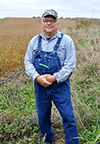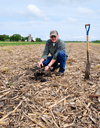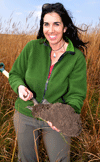Profiling Iowa's Conservation Successes in 2015 & 2016
|
 |
Farmer Adds Cover Crops to Suite of Conservation Practices
Fifth-generation Madison County farmer James Baur is following his family’s conservation traditions to help improve water quality in Badger Creek Lake, which was listed on the Iowa Department of Natural Resources (DNR) 303(d) list of impaired waters in 1998 due to excessive siltation and nutrient loading.
James Baur (PDF) | (html)
|
 |
New Conservation Practices for Century Old Farm
Even though Frederick Martens’ grandfather started farming his Madison County ground more than a century ago, Martens continues to implement the latest in conservation technology to sustain the family farm for at least 100 more years.
Frederick Martens (PDF) | (html)
|
 |
Iowa Farmer Sees Success Crimp Rolling Cereal Rye
Mark Haines of Sigourney is one of a handful of southeast Iowa farmers who shared a crimp roller to successfully terminate their cereal rye cover crop this spring.
Mark Haines (PDF) | (html)
|
 |
Iowa Farmer Mixed Up in Cover Crops
Buchanan County farmer Dick Sloan is using cover crop mixes on all of his corn and soybean acres to help improve water quality and soil health.
Dick Sloan (PDF) | (html)
|
 |
NRCS Helps Young Iowa Farmer Plan New Grazing System
Allamakee County livestock producer Ryan Collins used the experience and expertise of his local NRCS office to design and plan fencing, watering facilities, and other practices on his 170-acre farm.
Ryan Collins (PDF) | (html)
|
 |
Earthworms Replace Tillage Tools for Oskaloosa Farmer
Southern Iowa farmer Gene DeBruin is replacing costly tillage with the free tillage service provided by earthworms and cover crop roots. The Oskaloosa corn and soybean grower no longer tills his 330 acres of cropland, but instead relies on earthworms for tillage. He also plants cover crops for even more erosion control and superb soil structure.
Gene DeBruin (PDF) | (html)
|
 |
Families, Conservation Partners Collaborate on Unique Wetland Complex
Three families with adjoining property lines recently combined efforts with USDA’s Natural Resources Conservation Service (NRCS) and other conservation partners to restore pothole wetlands and upland prairie on former cropland and rough pasture, creating a 284-acre wildlife haven in northern Iowa.
Wetland Complex (PDF) | (html)
|
 |
McCunn Continues Family's No-till Tradition
Thirty-five years after starring in a video documenting his transition to no-till farming, the late Deane McCunn would be very proud of his grandson. Jason McCunn of rural Red Oak is continuing what his grandpa started by keeping his farm equipment above ground and leaving the soil undisturbed on the family’s Montgomery County farm.
McCunn (PDF, 3 MB) | (html) | Video (YouTube)
|
 |
County Leaders Stand Up for Stewardship
One Iowa county has decided that protecting the natural resources on their county-owned farm and showcasing it as an example of good land stewardship outweighs the financial benefits of taking top dollar per acre from a potential renter.
Allamakee (PDF, 1.7 MB) | (html)
|
 |
Father-Son Duo Investing in Conservation
Father-son farming duo Larry and Mark Lamborn are reinvesting payments earned through USDA’s Conservation Stewardship Program (CSP) to add additional conservation practices on their land, including 3,300 feet of terraces and improving yields.
Lamborn (PDF, 1 MB) | (html)
|
 |
Cleaning Up A Watershed Through Conservation
Linda Ritchie and her siblings have always been conscious of the quality of their drinking water. Growing up on their Sac County Farm – Bethune Family Farms – they drank straight from the well. Today, Ritchie is applying conservation practices on the family’s 740 acres to keep local water bodies, including nearby Black Hawk Lake, free from pollutants such as sediment, phosphorus and nitrates.
Ritchie (PDF, 3 MB) | (html)
|
 |
Cover Crops Just Seemed Like the Thing to Do
The more she read about cover crops and soil health, the more Marilyn Geidel became convinced she and her husband Wes should be trying them on their farm. “I have great interest in reading the farm magazines,” Marilyn explains. “The more I read, cover crops just seemed like the thing to do. It sounded good to us to build the soil and to prevent erosion on our hills.”
Geidel (PDF, 6 MB) | (html)
|
 |
'No One Will Treat the Land Like You Do'
Nearly 2,000 miles separates Ruth Rabinowitz from her family’s Iowa farmland. Without the advantage of growing up on a farm, the new partner in Rabinowitz Family Farms now finds herself serving as the family’s point person for managing 10 farms in six Iowa counties as well as one farm in South Dakota.
Rabinowitz (PDF, 5 MB) | (html)
|
 |
Lynn Betts: If You Believe Soil Is Alive, Treat It That Way
Most landowners who don’t actively farm their land, especially those who live away from it, don’t expect to or want to make day-to-day decisions on how the land is farmed. They leave that up to their tenant. But that doesn’t mean they don’t have the right and the responsibility to set the tone for long-term care of their land. In fact, that’s one of the most important things they can do, says Guthrie County, Iowa, absentee landowner Lynn Betts.
Betts (PDF, 10 MB) | (html)
|